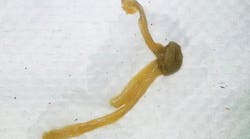Troubleshooter: Gross dental waterlines have new employee worried
QUESTION: I’m a recent grad and just got my first real gig at this great dental office. However, I’ve noticed something troubling. I want to address it but I’m not sure how to go about it. I am blessed at this new dental office to have my own operatory. But it seems the lines have not been flushed in a while. I looked under the tip of the suction line and saw grime buildup. I asked the other hygienist, who has been here for 20-plus years, what day of the week they flush the lines. She smirked and said they don’t, but not to quote her on that. I want to flush my lines but I don’t want to get the other hygienist in trouble. What can I do?
ANSWER FROM KAREN DAW, MBA, authorized OSHA trainer, consultant on safety, and owner of Daw Consulting:
Kudos to you for wanting to do something you learned in school, and feel in your gut should be done! The position you are in is very common and brings to mind a favorite quote from the NBC sitcom, “The Office.” Steve Carrell’s character, Michael Scott, is asked whether he would rather be feared or loved at work. He replies, “Easy. Both. I want people to be afraid of how much they love me."
Related reading
Dental unit waterlines: Trickier than you think
We are all taught at a young age not to ruffle feathers and to play nice in the sandbox. A new employee must quickly find the right balance between being liked and being respected. However, integrity should not be sacrificed, especially if it involves patient care. It is possible that the doctor is unaware of the recommendations regarding routine maintenance of the evacuation lines, or does know the protocol but is unaware whether it is being completed.
The Centers for Disease Control and Prevention (CDC) addresses backflow. Backflow, as you know, is when previously suctioned fluids in the tubing flows back into the patient’s mouth. This occurs when patients close their lips around the tip of the ejector. The analogy the CDC uses is when your beverage flows back into the cup after you use a straw. Backflow also occurs when the suction tubing is elevated above the patient's mouth.
As a result, the CDC advises, “Contact the manufacturer of the dental unit to review proper use and maintenance procedures, including appropriate cleaning and disinfection methods.” The Organization for Safety, Asepsis and Prevention (OSAP) also cites leading infection control experts regarding daily maintenance of the evacuation system, including the use of cleaners. In essence, there is a possibility one patient could suck up the saliva and other infectious materials of the previous patient. Um, ewww!
In addition to the possibility of cross contamination, proper maintenance of the entire vacuum system ensures that the units are functioning properly. This prevents costly repairs in the future. In an era when every minute is mapped out for us in patient care, a unit with decreasing suction capabilities can be stressful. Suction lines that are not performing up to par can also decrease productivity and profits. As the saying goes, “Time is money.”
Now armed with some good information, it’s time to bring this to the attention of the doctor. Prior to your chat, contact the dental unit manufacturer so that you have the company’s recommendations readily available. Don’t forget to bring a few pictures of what is lurking under the tip of your suction lines. What you described as “grime” is the accumulation of saliva, blood, other organic debris, and bacteria. A picture speaks a thousand words, and after the initial gag reflex, the doctor will see the importance of regular maintenance of the units.
Lead into your conversation by saying that you are committed to the success of the practice. Explain what you have seen and ask the doctor his or her thoughts. The employer is responsible for setting forth the expectations for the practice, and once the doctor is aware of what is occurring, he or she will most likely share with the entire team the importance of flushing the evacuation lines on a regular basis.
Finally, ask the doctor if you can work with the practice’s infection control coordinator on a protocol for your office. Propose that the manufacturer’s directions be added to the maintenance checklist. This removes the guesswork of whether cleaning the suction lines is being completed regularly. This also provides the practice with documentation. As any attorney will tell you, if you didn’t document it, it didn’t happen. Attorneys aren’t the only fans of proper documentation—the CDC and OSHA are too.
I hope this helps, and best of luck!
Resource: https://www.cdc.gov/oralhealth/infectioncontrol/questions/saliva.html
Editor's note: Originally posted in 2018 and updated regularly






